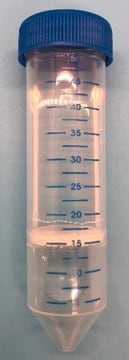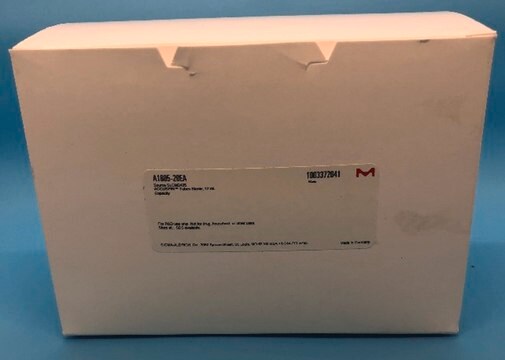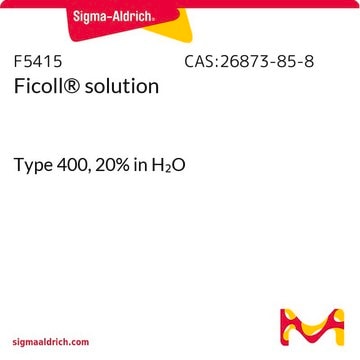Sucrose exerts an osmotic pressure of 300 mOsm at a concentration of about 0.25M, which is iso-osmotic with the contents of most mammalian cells. This concentration is approximately 81.25 grams/L or 8.125%, as per protocols used to remove platelets. Recommended procedures for removing platelets:
Perform Procedure 1077 or 1077/1119.
Collect the cell band and layer it over a second gradient.
A. Bottom layer = 1077-1
B. Top layer = 8.125% sucrose solution (prepared in deionized water).
C. Layer the cell suspension on top of the gradient formed in steps 1-2.
D. Use a 300 g spin for 10-15 minutes.
E. Depending upon the original volume of the cell suspension, times and speed may have to be adjusted to maximize cell recovery.
F. Use separate tubes for mononuclear and polymorphonuclear cells.
A2055
ACCUSPIN™ Tubes Sterile, 50 mL Capacity
radiation sterilized tube fitted with a high density polyethylene barrier
About This Item
Recommended Products
Quality Level
sterility
sterile; irradiated
form
tubes
application(s)
hematology
histology
storage temp.
15-25°C
General description
Application
- in the isolation of lymphocytes and other mononuclear cells.
- isolation of cord blood–derived endothelial progenitor cells.[1]
- isolate mononuclear cell layer from bone marrow samples.
- suitable for the purification of human bone marrow aspirates for the investigation of the therapeutic value of BET inhibitors for acute myeloid leukemia.
Principle
Quantity
Legal Information
Signal Word
Danger
Hazard Statements
Precautionary Statements
Hazard Classifications
Resp. Sens. 1 - Skin Sens. 1
Storage Class Code
12 - Non Combustible Liquids
WGK
WGK 3
Flash Point(F)
Not applicable
Flash Point(C)
Not applicable
Choose from one of the most recent versions:
Certificates of Analysis (COA)
Don't see the Right Version?
If you require a particular version, you can look up a specific certificate by the Lot or Batch number.
Already Own This Product?
Find documentation for the products that you have recently purchased in the Document Library.
Customers Also Viewed
Articles
The recent emergence of a number of highly functional nanomaterials has enabled new approaches to the understanding, diagnosis, and treatment of cancer.
The recent emergence of a number of highly functional nanomaterials has enabled new approaches to the understanding, diagnosis, and treatment of cancer.
The recent emergence of a number of highly functional nanomaterials has enabled new approaches to the understanding, diagnosis, and treatment of cancer.
The recent emergence of a number of highly functional nanomaterials has enabled new approaches to the understanding, diagnosis, and treatment of cancer.
-
How should a 4-20% sucrose gradient be used to reduce platelet contamination, as recommended in the user manual?
1 answer-
Helpful?
-
-
Does the Accuspin Tubes Product #A2055, which are prefilled with a frit, also contain EDTA or another anticoagulant?
1 answer-
None of the Accuspin spin tubes (filled or unfilled) contain any anticoagulant. It is expected that when blood is drawn, it is typically drawn into a vacuum tube that already contains an anticoagulant or it is necessary to add anticoagulant immediately after the blood draw is completed. The most common anticoagulants used are EDTA and Heparin.
Helpful?
-
-
Are Accuspin tubes compatible with blood that has been anticoagulated with ACD-A?
1 answer-
Certainly, Accuspin tubes are suitable for use with any blood containing an anticoagulant, with fresher blood being preferable. Regardless of the anticoagulant used, the anticoagulant is essentially washed away during the steps to remove the density gradient from the collected white blood cells. With ACD-A, the cell band is wider at the interface and the cells are more dispersed over a larger area, possibly due to the dextrose/glucose in the formulation. When using ACD-A, a somewhat unusual cell band is produced after the tubes are removed from the centrifuge. In comparison, cell bands with heparin, EDTA, sodium citrate, and other typical anticoagulants typically provide a rather narrow cell band when viewed from the side of the Accuspin tube.
Helpful?
-
-
Is Accuspin (A2055) suitable for use with canine blood?
1 answer-
The suggestion is to make a decision based on individual circumstances.If currently using a plain centrifuge tube for collecting PBMCs from canine blood using a single density gradient, the Accuspin Tubes can be used for the same collection, provided that the G force does not exceed 1000G and a single density gradient is used.
Helpful?
-
-
Can I remove the Frit after collecting the mononuclear cells to recover the granulocytes?
1 answer-
When using the Accuspin System to collect Peripheral Blood Mononuclear Cells (PBMCs), there is no expectation that the neutrophils can be recovered. Although it is possible to dislodge the frit, some granulocytes will be suspended in the lower layers of the density gradient. The remaining granulocytes will appear as a gray layer on top of the packed red blood cells.
In theory, the end-user may be able to collect this buffy coat that sits atop the packed red blood cell layer. It is recommended to either perform a lysis step to lyse the red blood cells, or run the cells back over another density gradient - such as Histopaque 11191 that has a density of 1.119 g/ml.
Instead of performing this 2-step procedure that has not been validated, the more logical option would be to simply run the whole peripheral blood over a 2-step discontinuous gradient. Currently, Histopaque 10771 and Histopaque 11191, are offered. The Histopaque 11191 instructions for use are available in the DOCUMENTATION section in the 'More Documents' tab of the product detail page:
https://www.sigmaaldrich.com/product/sigma/a2055#product-documentation
https://www.sigmaaldrich.com/deepweb/assets/sigmaaldrich/product/documents/193/872/a2055pis.pdfHelpful?
-
Active Filters
Our team of scientists has experience in all areas of research including Life Science, Material Science, Chemical Synthesis, Chromatography, Analytical and many others.
Contact Technical Service










